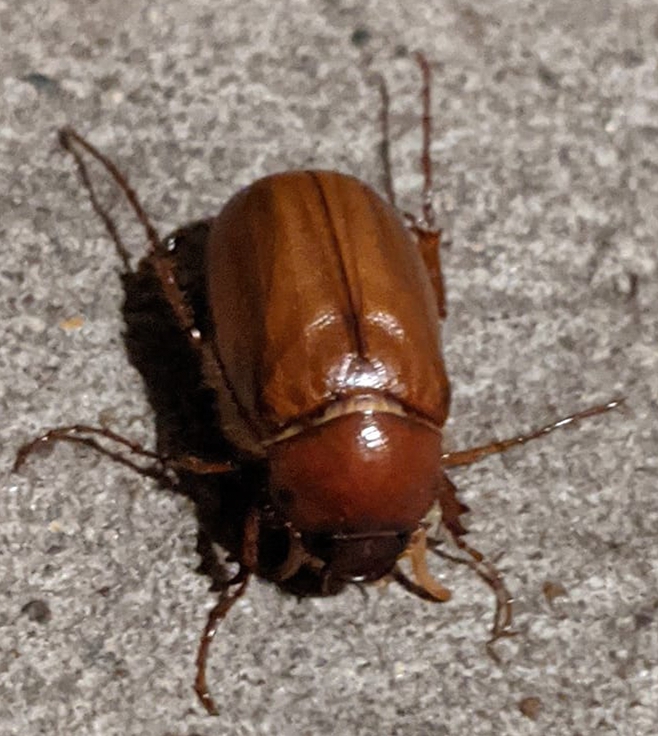by M. Kathy Raines

June bugs make my heart sing. Sheathed in glossy caramel shells, they zip about within swaths of springtime porch light—with some hapless beetles smashing into bulbs and landing sprawling, legs a-wriggle, onto concrete. To schoolchildren, they are happy harbingers of summer.
Groundskeepers and farmers, though, do not share this joy. While leaf-eating adult beetles do little damage, root-eating larvae, or grubworms, can ruin lawns, football fields and golf courses, as well as crops like corn, sorghum and sugarcane.
Thebeetle’s inch-long, cream-colored, brown-headed larvae feed on the roots of crops, ornamental plants and grass, the latter of which, with its withered patches, comes to resemble a worn-out carpet. The adult Junebug, a nocturnal feeder, eats various leaves.
South Texas’ common June bug (Phyllophaga crinite)—which generally appears in late May— is one of hundreds of scarab beetles in the order Coleoptera—whose name, from Greek, is a combination of “sheath” and “wings”, denoting the creatures’ protective front wings. Its genus, Phyllophaga, combines two Greek words to mean “leaf eater”, and its species name, crinita, comes from a Latin word meaning “bearded” to describe the noticeably hairy front of its thorax.
This coppery-colored adult beetle grows from 1/2 to 5/8 inches long. Its spindly legs, more suitable for digging than walking, may catch on screen doors or clothing. Like its kin, it has a double pair of wings. It holds its elytra, or hardened protective forewings, to the side as it flies; these generate lift, while the inner wings do the flying.
Though it appears that these beetles fly from distant lands to dance in our porch lights, these springtime visitors have just emerged from buried pupae in our soil, ready to dine and mate.
Heavy rainfall or irrigation usually precipitates beetles’ sometimes three weeks-long mating flights. The female, not as keen on flying, sails a short way, emitting attractive pheromones, whose invisible trail the male follows. Securing himself with his mandibles, he hangs on a receptive female’s back. Then he falls backward, and she pulls him along as they continue copulating, perhaps for a few hours.
The female immediately burrows into the earth, laying her clutch of 40 or more eggs, while the male continues flying and feeding. These beetles undergo complete metamorphosis, meaning they pass through egg, larval, pupal and adult stages. Adults die a few weeks to a month after mating.
Larvae eat their fill as they undergo three stages, or instars. Then they descend three to six inches into the soil to pupate, a stage lasting a few weeks. Pupae, starting out dark brown, lighten, then become iridescent. New adults emerge in late spring or summer to mate. In northern Texas or Oklahoma, this process may require two years, but in South Texas, only one.
This species thrives in grasslands, particularly in moist soil, in Texas and Tamaulipas, several southern and a few Midwestern states. In daytime, these beetles rest under bark or leaves.
With their heavy shells, these weak, clumsy fliers reach about five mph, producing only 45 wingbeats per second to, say, a mosquito’s 280 to 310. Fiercely attracted to light, June bugs fly straight forward, sometimes smashing into screens, walls or even people—who mistakenly think they’re being bitten.
Five to ten grubworms per square foot can seriously damage crops. Exterminators may destroy them with chemicals, and some employ nematodes, or roundworms, in their eradication.


